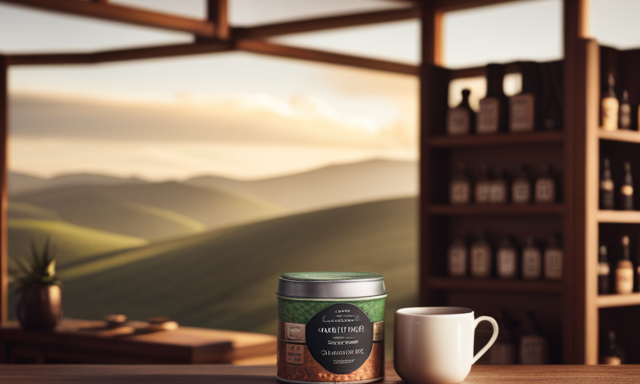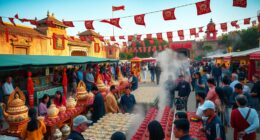Step back in time and venture into the ancient world of tea with me as we delve into the origins and health benefits of the mysterious and captivating pu erh tea.
This exceptional dark elixir, exclusively produced in China’s enchanting Yunnan province, has stood the test of time, boasting a rich history that dates back centuries. Like a hidden gem waiting to be discovered, pu erh tea tantalizes the taste buds with its unique flavors and enchanting aromas.
But what sets pu erh tea apart from the rest? This remarkable tea undergoes a natural fermentation process, resulting in a drink that not only delights the senses but also offers a plethora of health benefits.
From aiding in weight loss and reducing blood sugar levels to protecting against cardiovascular diseases, pu erh tea is a true powerhouse of wellness.
Join me on this journey as we explore the origins of pu erh tea, discover the artistry behind its production methods, and uncover the scientific evidence that supports its health benefits.
So, grab your favorite teapot and prepare to indulge in the ancient fermented tea that has captivated tea enthusiasts for centuries.
Key Takeaways
- Pu erh tea is one of the oldest types of tea in the world and is exclusively produced in the Chinese Yunnan province.
- It is made from Camellia sinensis tea leaves and undergoes natural fermentation through aging or controlled fermentation.
- Pu erh tea has numerous health benefits, including weight loss, lowering blood sugar, and reducing the risk of cardiovascular diseases.
- The presence of bacteria in pu erh tea may contribute to its health benefits, such as its hypolipidemic and anti-inflammatory effects.
Origins and Production Methods
I’ve learned that Pu erh tea is exclusively produced in the Chinese Yunnan province and made from fermented Camellia sinensis tea leaves. Pu erh tea has a rich history that dates back over a thousand years. It is believed to have been discovered during the Tang Dynasty and has since become one of the most prized teas in China.
The traditional fermentation process is what sets Pu erh tea apart from other types of tea. After the leaves are harvested, they undergo a natural aging process or controlled fermentation. This fermentation process is what gives Pu erh tea its distinctive flavor and aroma. The length of fermentation can vary, with some teas being aged for several years or even decades.
During this fermentation process, beneficial bacteria and microorganisms develop, which contribute to the health benefits associated with Pu erh tea. These bacteria help to break down the tea leaves and produce unique compounds that have been found to have a positive impact on cholesterol levels, blood sugar regulation, and cardiovascular health.
Overall, the origins and production methods of Pu erh tea make it a truly unique and fascinating beverage with a long and storied history.
Health Benefits
One surprising perk of enjoying Pu erh tea is its potential to aid in weight loss. Studies have shown that Pu erh tea can help increase metabolism and promote fat burning, making it a popular choice among those looking to shed a few pounds. Additionally, Pu erh tea has been found to have positive effects on cardiovascular health. It has been shown to reduce bad cholesterol levels and improve blood lipid profiles, which can help lower the risk of heart disease and stroke. The unique fermentation process of Pu erh tea may contribute to these health benefits, as it produces certain compounds that have hypolipidemic and anti-inflammatory effects. So, not only can drinking Pu erh tea be a delicious and enjoyable experience, but it may also have some positive effects on weight management and cardiovascular health.
| Weight Loss | Cardiovascular Health | |
|---|---|---|
| Pu erh Tea | Potential | Positive Effects |
Brewing and Consumption Tips
When brewing and enjoying Pu erh tea, I find it helpful to use freshly boiled spring water and steep the tea multiple times to fully savor its rich flavors. Here are some tips for brewing and consuming Pu erh tea:
-
Different Brewing Techniques: Pu erh tea can be brewed using both eastern and western techniques. Eastern brewing involves a shorter steeping time, usually around 15-30 seconds, while western brewing requires a longer steeping time, around 2-5 minutes. Experiment with both methods to find your preferred taste.
-
Optimal Steeping Times: The steeping time for Pu erh tea varies depending on the type and age of the tea. Generally, raw Pu erh tea benefits from longer steeping times, while ripe Pu erh tea can be brewed for shorter durations. Start with shorter steeping times and gradually increase to find the perfect balance.
-
Re-steeping: One of the unique qualities of Pu erh tea is its ability to be steeped multiple times. Each steeping brings out different flavors and aromas, so don’t be afraid to re-steep the tea leaves up to 20 times.
-
Enjoy After a Meal: Pu erh tea is best consumed after a meal as it aids in digestion and helps with the absorption of nutrients. So, sit back, relax, and savor the complex flavors of this ancient fermented tea.
Frequently Asked Questions
What is the difference between raw (sheng) and ripe (shou) pu erh tea?
Raw (sheng) pu erh tea improves with aging, while ripe (shou) pu erh is suitable for immediate consumption. Both types offer health benefits, such as weight loss and reducing the risk of cardiovascular diseases, thanks to their natural fermentation process.
How long does it take for pu erh tea to age and develop its unique flavors?
Pu erh tea can take years to age and develop its unique flavors. Factors like storage conditions, temperature, humidity, and the quality of the tea leaves all play a role in the aging process and flavor development of pu erh tea.
Are there any specific storage requirements for pu erh tea to maintain its quality?
To maintain the quality of Pu erh tea, store it in a cool, dry place away from strong odors. Proper storage conditions are crucial for the aging process, preserving the tea’s unique flavors, and maximizing its health benefits. When brewing, use freshly boiled spring water and follow cultural techniques for the best results.
Can pu erh tea be blended with other types of tea or ingredients?
Yes, pu erh tea can be blended with other types of tea or ingredients, providing endless blending possibilities. This allows for a unique flavor profile while still benefiting from pu erh’s health benefits.
Is there a specific time of day or occasion when pu erh tea is traditionally consumed?
Pu erh tea is traditionally consumed after a meal in Chinese culture. It is believed to aid digestion and cleanse the palate. Brewing techniques vary, but using freshly boiled spring water and multiple steepings are common practices.
Conclusion
In conclusion, pu erh tea offers a multitude of health benefits, thanks to its rich history and unique production methods. Its natural fermentation process creates a distinct flavor and aroma, reminiscent of a fine wine. From aiding in weight loss to reducing the risk of cardiovascular diseases, the benefits of this ancient tea are vast.
So, the next time you sit down to enjoy a cup of pu erh tea, savor the experience like a gentle breeze on a warm summer day. Know that you’re nourishing your body and mind.










